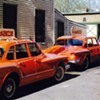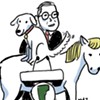Published October 1, 2003 at 4:00 a.m.
The Lost Ski Areas Project began as a twinkle in the eye of a curious teenager. Twelve-year-old Jeremy Davis was heading to North Conway, New Hampshire, from his home in Chelmsford, Massachusetts, on his first big family ski trip. He had just fallen in love with the sport and was keenly interested in all its aspects. Driving up Route 16 through West Ossipee, the family passed under the old gondola cable of the closed Mt. Whittier ski area. Later on the same trip, Davis spied Tyrol, another closed resort, from the summit of Black Mountain.
"That got me thinking about ski history," Davis says now, "so over the next few years I tried to find more information, but it was hard. These were the pre-Internet days, of course."
The task of finding lost ski areas became a family scavenger hunt. Old brochures or sites on old road atlases would lead to a detour on the next ski trip. Fortunately for Davis, his parents got into it. "It was fun - they were always asking if we were going to find another area this trip."
His collection of materials found a new form when he went off to college in 1996. "I got a computer and learned how to use a scanner," Davis recounts, "and by 1998 I put together a basic Web page with six areas." As word spread about the project, the site "started to go crazy."
Crazy enough that now the New England Lost Ski Areas Project site (www.nelsap.org) lists a whopping 541 defunct ski sites in the six-state region. "This is what I think the Internet should be for - the free exchange of information," Davis opines. He views his task as "cataloging memories" and welcomes contributions.
Davis has assembled data from old books and magazines, original trail maps and bro-chures, pictures of how some of the areas looked then and how the "ruins" look now, as well as the recollections of people who remember skiing at the now-defunct areas when they were in operation. NELSAP joins other "lost" documentation projects in an interesting genre of Amer-icana that also catalogues by-gone amusement parks, railroads and diners.
Although Vermont has a special place in the history of skiing, it's a distant third in the lost-area standings, with 96 counted to date. Topographic-ally challenged Massachusetts leads the pack with 160, closely trailed by New Hampshire, which has 159. Davis chalks up Massachusetts' surprising lead to the state's big population base and a number of dinky hills outside of Boston that are now completely developed. Elsewhere in New England, Maine claims 69, Connecticut 54, and Rhode Island just four.
The Vermont page of NELSAP memorializes well-known old areas such as the Underhill Ski Bowl and Hogback Mount-ain with extensive documentation. But the site also includes the most obscure slopes, some of which never actually opened. In Chittenden County, the towns of Hines-burg, Milton, Jericho, Under-hill, Essex Junc-tion, St. George/ Williston and even South Burlington have listings.
A few clicks around the site reveal some fascinating stories. One contributor tells the tale of the Town & Country Motor Inn in Stowe back in the early '60s. It seems the owner, a man with considerable spare cash, opened Vermont's first and last Playboy Club and decided to "add" a ski area. He trucked in a ton of dirt, creating a hill with around 30 feet of vertical drop, and put in a four-tower lift. According to Vermont Tramway Department records, the lift was 344 feet long. It closed in 1970. No word on what happened to the Bunnies.
It seems that virtually every town in Vermont once had its own little slope. For instance, a few pictures on the NELSAP site show the remnants of a small, unnamed South Burlington area that operated a single rope tow. The location is now home to the Sheraton Hotel. While the former trails are completely overgrown, the posts of the lift shed and a piece of an old metal bull wheel remain as artifacts.
Vermont can claim the "ultimate" lost ski area - the White Cupboard Inn Ski Way on Clinton Gilbert's farm in Woodstock, the origin of the modern resort. David Dodd, an area handyman, built a rope tow out of an old Model T engine for less than $500. Local ski instructor Robert Bourdon took the inaugural ascent on January 18, 1934, becoming the nation's first skier to avoid hiking up to ski down. A state historical marker sits at the spot on Route 12. Vermont was also home to the first "J-bar" and "T-bar" lifts, as well as the first chair lift, in 1940 at Stowe.
As to the issue of "poachers" - backcountry skiers who seek out untracked slopes that may or may not be open to public use - Davis is cautious. "I keep it kind of cryptic," he says. "The last thing I want to do is to have private- property owners upset."
In addition to preserving New England's skiing history, Davis has a day job as a professional meteorologist at North Country Weather in Glens Falls, New York. He earned his degree in the field from Lyndon State College. During those years, Davis says, he had some memorable internships. The highlight was spending a summer on top of Mount Washington; New Hampshire's famous extreme-weather site is still the world record-holder for maximum winds at 231 mph. The anemometer hit just 90 mph while Davis was there, but June snow and fabulous sunsets were also part of the package.
Davis now divides his weather forecasting between global and local perspectives. One part of North Country Weather is called Weather Routing, Inc. The firm, in business since 1961, provides worldwide marine weather for commercial shipping and private yachts. Their motto: "Oceans of Experience." Davis spent one recent day advising anxious mariners about the vagaries of Hurricane Isabel.
He also contributes weather forecasts to the Glens Falls TV station, WNCE Channel 8, and welcomes opportunities to personally test his powder predictions. Still faithful to his downhill skis, he favors quirky, small areas such as West Mountain, a three-lift, 21-run area near his home.
Davis has now spent half his life documenting lost ski areas. What began as a small hobby has snowballed into something much larger, and submissions are still coming in. His significant contribution to Alpine history has earned Davis a seat on the board of the New England Ski Museum. His latest challenge? Listing the closed areas of New York State. As for NELSAP contributions, Davis predicts "there won't be a whole lot more, maybe 10 more in Vermont. And I think we're getting towards the last 30 or 40 in New England."
When hardcore skiers hit the slopes this winter, accustomed to full-coverage snowmaking, buffed-out grooming and high-speed lifts, they probably won't be thinking about history. But the technological achievements of the modern resort stand on the shoulders of skiing's local pioneers. Thanks to Jeremy Davis, the memories of hundreds of small-town ski runs live on.
More By This Author
Speaking of...
-

Michael Krasnow Has Spent Decades Giving Kids Skis, Snowboards and a Taste of Independence
Jan 31, 2024 -

Video: Ice Fishing for Rainbow Smelt in Plymouth With Zachary and Fisher McNaughton and Fish Biologist Shawn Good
Feb 9, 2023 -

Essay: Learning to Ice Skate Is Easier Than You Think
Dec 7, 2021 -

What Can I Do to Get More Hang Time With My Ski-Bunny Buds?
Nov 10, 2021 -

Games On: With Time Running Short, Gov. Scott Green-Lights Winter Sports
Feb 10, 2021 - More »
Comments
Comments are closed.
From 2014-2020, Seven Days allowed readers to comment on all stories posted on our website. While we've appreciated the suggestions and insights, right now Seven Days is prioritizing our core mission — producing high-quality, responsible local journalism — over moderating online debates between readers.
To criticize, correct or praise our reporting, please send us a letter to the editor or send us a tip. We’ll check it out and report the results.
Online comments may return when we have better tech tools for managing them. Thanks for reading.











































